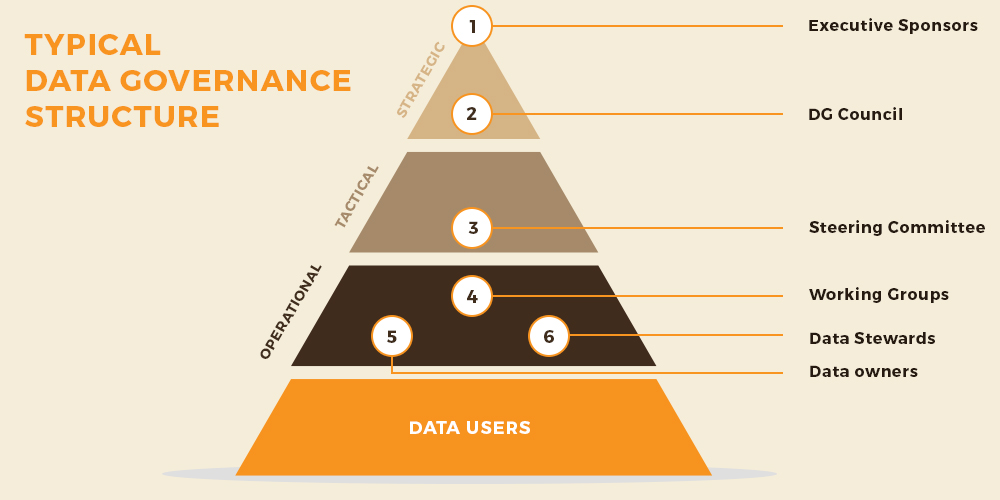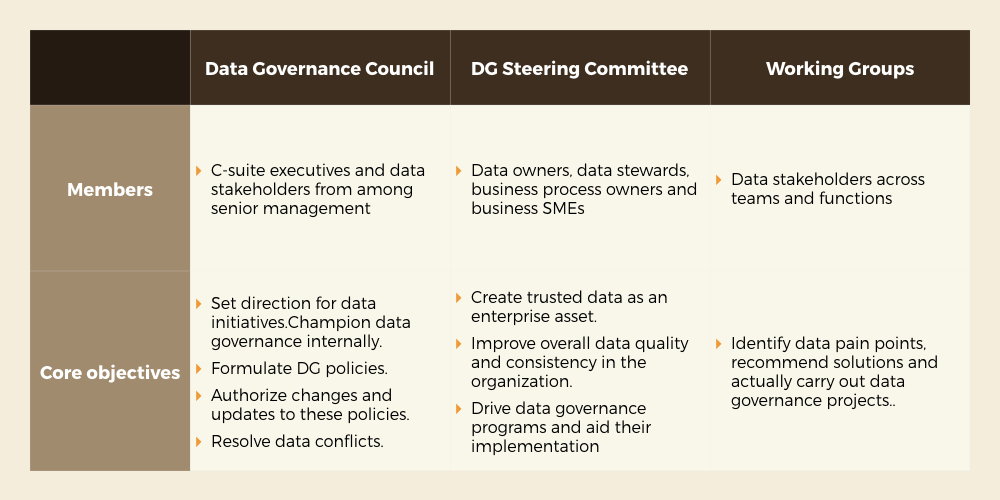
In the past, we have spoken about the role played by a Chief Data Officer (and indeed, if your organization needs one) as well as the significance of a Data Governance Council (DGC), an apex body that will drive your organization’s data governance initiatives. But both of these roles are at a strategic level.

As we really get down to the brass tacks and come to the teams’ roles at tactical and operational levels, what should your data governance organisational structure look like? Like a lot of questions in life, this one has no single right answer.
Strategic Level
The focus of your data governance project and the maturity and size of the organization will certainly influence this structure. However, we can also learn from the practices and patterns followed by organizations that are data pioneers.
The Data Governance Council (DGC) is the apex body that internally champions data governance and drives awareness and transformation within the organization. It is also the final decision authority in case of unresolved data conflicts. Read more about it here.

Tactical level
At the tactical level lies the Steering Committee, a cross-functional body that acts as the interface between the DGC and the working groups. The Steering Committee is responsible for a lot of the on-ground implementation of data governance principles. In this blog, we will delve a little deeper into the objectives and functioning of the Steering Committee.
Operational level
The working groups, in turn, are cross-functional teams that identify data-related pain points, collaboratively identify solutions and work towards implementing them. They are composed of data owners, data stewards, and data users. They hold accountability, champion data governance, or use organizational data to carry out their business roles. Of these, data stewards are of particular interest and you can read more about them here.

The data governance steering committee
- Composition — Like all teams playing an active role in the data governance program, the steering committee too must have representatives from the business side and the IT side. Together, they must understand both the business’ data needs and the organization’s technological constraints and challenges.
- Size — This committee needs to be big enough to represent the key stakeholders but also small enough to make sure that tasks are carried out efficiently. Thus, depending on the size and complexity of the organization, this team’s size can range from 5 to 10.
- Core objectives — The steering committee has the following major responsibilities:
- It will be the governing body and final voice regarding organizational data processes, policies, and standards. Any changes surrounding the manipulation of data must be authorized by the committee before implementation.
- It must strengthen data-driven decisions by acting as the in-between for the data governance council and the working groups.
- Improve the consistency of data use across the organization and create trusted data as an enterprise asset.
For a steering committee to be successful, it must necessarily be the final authority to make decisions about data. The steering committee decides how the organization’s data is maintained, what the data contains, and how long the data is kept in the system according to regulatory requirements.
A fine balance
There is no doubt that having a steering committee has definite advantages. As Vaughan Robertson, Data Governance Chair at Beca, said, “Before I started chairing the data governance group, I would never have thought it was necessary.”
However, common perception holds that the more the number of people involved in a project, higher the chance of inefficiencies and delays. This is a real danger, one to be conscious of while designing the structure of your data governance program team. Do make sure that the committee has a clear, specific agenda and mandate so that it stays on the straight and narrow.
Have more questions on setting up a Data Governance team roles in your organisation? Schedule a meeting with our consultants now.


